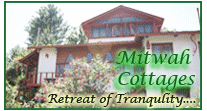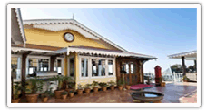|
|
|
| |
| |
Travel destination in India, Bandhavgarh |
|
|
| |
General Information about BANDHAVGARH |
Bandhavgarh : The land of Tigers.
Area : 450 sq. km (Core area: 105 sq. km)
Altitude : 800 m
Language : Hindi, English
Best time to visit : February to June.
STD Code : 07653
State : Madhya Pradesh.
Main Wildlife Found : Tigers, Leopards, Bears. |
About Bandhavgarh
Bandhavgarh National Park is located in Umaria district of Madhya Pradesh state in India. Bandhavgarh was declared a national park in 1968 with an area of 105 km². The buffer is spread over the forest divisions of Umaria and Katni and totals 437 km². The park derives its name from the most prominent hillock of the area, which is said to be given by Lord Rama to his brother Laxman to keep a watch on Lanka. Hence the name Bandhavgarh (Bandhav=Brother, Garh=Fort). This is a Small National Park, Compact, yet full of game.
The density of the tiger population at Bandhavgarh is the highest known in India. This is also white tiger country. These have been found in the old state of Rewa for many years. Maharaja Martand Singh captured the last known in 1951. This white tiger, Mohan, is now stuffed and on display in the palace of the Maharajas of Rewa.
CLIMATE
The climate is north Indian monsoon, characterized by well-defined winters, summers and rains. The mercury has been recorded to drop to a low of 2°C (in January) and a high of 44°C (in may). Average rainfall is 1173 mm, most of which falls during the monsoons. Some rains result from the cyclones as well, between the months of November and February.
HOW TO REACH
By Air : The nearest airport is at Khajurao at a distance of 230-kms. It is also connected by various domestic airline services with Agra, Delhi and Varanasi.
By Rail : The nearest railhead Umaria is at 30-kms on the Katni-Bilaspur section of South-Eastern Railways. Another nearest railhead is at Satna on the Bombay-Howrah main line of the Central Railways.
By Road : Bandhavgarh National Park is situated on the Satna-Umaria and Rewa-Umaria highway. Madhya Pradesh State Transport Bus Services connect the national park to the cities like Rewa, Satna, Katni and Umaria.
PLACES TO VISIT IN BANDHAVGARH
• The park : Statue of Shesh-Saiya at Bandhavgarh National ParkBandhavgarh (the present Tala Range) enjoyed almost complete protection under the Maharajas of Rewa during the pre-independence era. The jungle though had a price to pay for the considerable protection afforded by the Maharajas, Bandhavgarh was a declared game reserve and the Royal family exclusive hunting privileges.
• The caves : Image of Bandhavgarh cavesThere are 39 caves in the Bandhavgarh fort and in the surrounding hillocks up to a radius of about 5 km. The oldest cave is of 1st century AD. Several caves carry inscriptions in Brahmi script. Some caves have embossed figure such as those of tiger, pig, elephant and horseman. Badi gufa, the largest cave, has broad entrance, nine small rooms and several pillars. It has been dated back to the 10th century AD. The cave appears to be primitive lacking the elaborate statues and carvings seen in the caves of Buddhist period. Its purpose remains mystery.
• The Fort : No records are available to show when Bandhavgarh fort was constructed. It is thought, however, to be some 2000 years old, and there are references to it in the ancient books, the “Narad-Panch Ratra” and the ‘Shiva Purana”. Various dynasties have ruled the fort: for example, the Sengars from 5th century AD and the Kalchuris from 10th century AD. In the 13th century AD, the Baghels took over, ruling from Bandhavgarh until 1617, when Maharaja Vikramaditya Singh moved his capital to Rewa. The last inhabitants deserted the fort in 1935.
• Jeep and Elephant Safari : The wildlife viewing can be enjoyed in two ways in Bandhavgarh National Park - Jeep Safari and Elephant Safari. Jeep safaris from the early morning hours till evening hours are the special attractions in the national park. A forest department guide always accompanies you while your jeep safari within the park. Elephant safari are organised for tracking the tigers in the early morning. White Tigers: Since yesteryears, the Sal forests of Bandhavgarh National Park have been the favourite habitat of the white tigers. The Bandhavgarh Park is the first place where the white tigers were spotted for the first time. At around eight occasions, the white tigers were seen in the national park. The Maharaja of Rewa successfully bred the white tigers in Rewa.
|
|
|
| |
|
|
|







